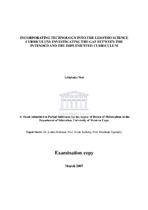| dc.description.abstract | The inclusion of technology in the school curriculum has been a concern in many countries following the 1990 Jomtien World Conference on Education for ALL (Jenkins, 1996). However, there are different perspectives and views about technology education. As a result technology has been included in the school curriculum in varied ways.In recognition of the importance of technology in economic development, Lesotho has attempted to include technology in the school curriculum by incorporating science and technology. This study evaluated the Lesotho science curriculum which incorporates technology. The evaluation study is based on the framework first proposed by Stake (1967). Stake’s model addresses the relationship between the intended curriculum and the implemented curriculum (Stenhouse, 1988). In this study the intended curriculum is defined as the curriculum plan as depicted in the curriculum materials such as the syllabus, the examinations questions papers and the textbook which was used as an exemplary material for teaching the science-technology curriculum. The implemented curriculum is viewed as what actually happened at school level as teachers tried to interpret the curriculum developer’s plan. Although Stake’s model served as a guide in the collection and analysis of empirical data, other theoretical areas supported it. These included Gardner’s (1990) approaches to the incorporation of science and technology; the constant comparative approach (Merriam, 1998); and some aspects of curriculum theory, particularly curriculum development and curriculum evaluation as espoused in the works of certain scholars (e.g. Ornstein and Hunkins, 2004; Stenhouse, 1988). The study was designed as a multiple-site case study (Merriam, 1998). The sites where in-depth study of the implemented curriculum was done were four high schools in Lesotho. The intended curriculum was mainly examined by analysing the curriculum materials such as the syllabus, the examinations question paper and the textbook. The methods that were used for collecting the data were interviews, classroom observations, document analysis, and the achievement tests. | en_US |

